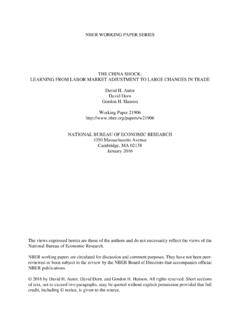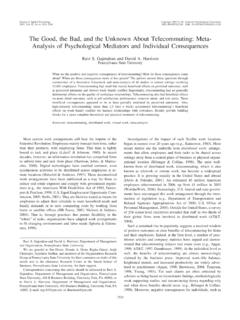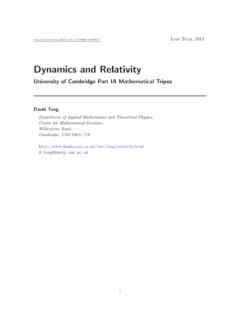Transcription of Fundamentals of Wireless Communication1 - Stanford University
1 Fundamentals of Wireless Communication1 . david Tse, University of California, Berkeley Pramod Viswanath, University of Illinois, Urbana-Champaign December 9, 2004. 1 Draft, to be published by Cambridge University Press, which owns the copyright. Online version is available with their permission. Comments will be much appreciated; please send them to or Contents 1 Introduction 12. Book Objective .. 12. Wireless Systems .. 13. Book Outline .. 16. 2 The Wireless Channel 21. Physical Modeling for Wireless Channels .. 21. Free space, fixed transmitting and receive antennas .. 23. Free space, moving antenna .. 24. Reflecting wall, fixed antenna .. 25. Reflecting wall, moving antenna .. 27. Reflection from a Ground Plane .. 29. Power Decay with Distance and Shadowing .. 30. Moving Antenna, Multiple Reflectors .. 31. Input/Output Model of the Wireless Channel .. 32. The Wireless Channel as a Linear Time-Varying System .. 32. Baseband Equivalent Model.
2 34. A Discrete Time Baseband Model .. 37. Discussion Degrees of Freedom .. 40. Additive White Noise .. 41. Time and Frequency Coherence .. 42. Doppler Spread and Coherence Time .. 42. Delay Spread and Coherence Bandwidth .. 44. Statistical Channel Models .. 47. Modeling Philosophy .. 47. Rayleigh and Rician Fading .. 48. Tap Gain Autocorrelation Function .. 50. Example Clarke's Model .. 51. Bibliographical Notes .. 55. Exercises .. 56. 1. Tse and Viswanath: Fundamentals of Wireless Communications 2. 3 Point-to-Point Communication: Detection, Diversity and Channel Uncertainty 64. Detection in a Rayleigh Fading Channel .. 65. Noncoherent Detection .. 65. Coherent Detection .. 68. From BPSK to QPSK: Exploiting the Degrees of Freedom .. 72. Diversity .. 76. Time Diversity .. 76. Repetition Coding .. 78. Beyond Repetition Coding .. 80. Example Time Diversity in GSM .. 86. Antenna Diversity .. 88. Receive Diversity .. 89. Transmit Diversity: Space-Time Codes.
3 90. MIMO: A 2 2 Example .. 94. Frequency Diversity .. 100. Basic Concept .. 100. Single-Carrier with ISI Equalization .. 102. Direct Sequence Spread Spectrum .. 109. Orthogonal Frequency Division Multiplexing .. 114. Impact of Channel Uncertainty .. 122. Noncoherent Detection for DS Spread Spectrum .. 122. Channel Estimation .. 125. Other Diversity Scenarios .. 127. Bibliographical Notes .. 131. Exercises .. 132. 4 Cellular Systems: Multiple Access and Interference Management 143. Introduction .. 143. Narrowband Cellular Systems .. 146. Narrowband allocations: GSM system .. 147. Impact on Network and System Design .. 150. Impact on Frequency Reuse .. 151. Wideband Systems: CDMA .. 152. CDMA Uplink .. 155. CDMA Downlink .. 170. System Issues .. 171. Wideband Systems: OFDM .. 174. Allocation Design Principles .. 174. Hopping Pattern .. 175. Signal Characteristics and Receiver Design .. 177. Tse and Viswanath: Fundamentals of Wireless Communications 3.
4 Sectorization .. 178. Example Flash-OFDM .. 179. Bibliographical Notes .. 181. Exercises .. 182. 5 Capacity of Wireless Channels 195. AWGN Channel Capacity .. 196. Repetition Coding .. 196. Packing Spheres .. 197. Discussion Capacity-Achieving AWGN Channel Codes .. 199. Resources of the AWGN Channel .. 201. Continuous-Time AWGN Channel .. 202. Power and Bandwidth .. 202. Example Bandwidth Reuse in Cellular Systems .. 205. Linear Time-Invariant Gaussian Channels .. 209. Single Input Multiple Output (SIMO) Channel .. 209. Multiple Input Single Output (MISO) Channel .. 210. Frequency-Selective Channel .. 211. Capacity of Fading Channels .. 217. Slow Fading Channel .. 218. Receive Diversity .. 221. Transmit Diversity .. 222. Time and Frequency Diversity .. 227. Fast Fading Channel .. 231. Transmitter Side Information .. 236. Example Rate Adaptation in IS-856 .. 244. Frequency-Selective Fading Channels .. 247. Summary: A Shift in Point of View.
5 248. Bibliographical Notes .. 252. Exercises .. 253. 6 Multiuser Capacity and Opportunistic Communication 266. Uplink AWGN Channel .. 267. Capacity via Successive Interference Cancellation .. 267. Comparison with Conventional CDMA .. 271. Comparison with Orthogonal Multiple Access .. 271. General K-user Uplink Capacity .. 273. Downlink AWGN Channel .. 275. Symmetric Case: Two Capacity-Achieving Schemes .. 276. General Case: Superposition Coding Achieves Capacity .. 279. Discussion SIC: Implementation Issues .. 283. Tse and Viswanath: Fundamentals of Wireless Communications 4. Uplink Fading Channel .. 285. Slow Fading Channel .. 285. Fast Fading Channel .. 287. Full Channel Side Information .. 289. Downlink Fading Channel .. 292. Channel Side Information at Receiver Only .. 293. Full Channel Side Information .. 294. Frequency-Selective Fading Channels .. 294. Multiuser Diversity .. 295. Multiuser Diversity Gain .. 295. Multiuser versus Classical Diversity.
6 298. Multiuser Diversity: System Aspects .. 300. Fair Scheduling and Multiuser Diversity .. 301. Channel Prediction and Feedback .. 308. Opportunistic Beamforming using Dumb Antennas .. 309. Multiuser Diversity in Multi-cell Systems .. 318. A System View .. 319. Bibliographical Notes .. 325. Exercises .. 326. 7 MIMO I: Spatial Multiplexing and Channel Modeling 342. Multiplexing Capability of Deterministic MIMO Channels .. 343. Capacity via Singular Value Decomposition .. 343. Rank and Condition Number .. 346. Physical Modeling of MIMO Channels .. 347. Line-of-Sight SIMO channel .. 348. Line-of-Sight MISO Channel .. 350. Antenna arrays with only a line-of-sight path .. 351. Geographically separated antennas .. 352. Line-of-sight plus one reflected path .. 359. Modeling of MIMO Fading Channels .. 364. Basic Approach .. 364. MIMO Multipath Channel .. 365. Angular Domain Representation of Signals .. 367. Angular Domain Representation of MIMO Channels.
7 370. Statistical Modeling in the Angular Domain .. 372. Degrees of Freedom and Diversity .. 372. Example Degrees of Freedom in Clustered Response Models 375. Dependency on Antenna Spacing .. 380. Rayleigh Fading Model .. 387. Bibliographical Notes .. 390. Tse and Viswanath: Fundamentals of Wireless Communications 5. Exercises .. 390. 8 MIMO II: Capacity and Multiplexing Architectures 393. The V-BLAST Architecture .. 394. Fast Fading MIMO Channel .. 396. Capacity with CSI at Receiver .. 396. Performance Gains .. 399. Full CSI .. 408. Receiver Architectures .. 411. Linear Decorrelator .. 411. Successive Cancellation .. 417. Linear MMSE Receiver .. 419. Information Theoretic Optimality* .. 427. Discussion Connections with CDMA Multiuser Detection and ISI Equalization .. 429. Slow Fading MIMO Channel .. 431. D-BLAST: An Outage-Optimal Architecture .. 433. Sub-optimality of V-BLAST .. 433. Coding Across Transmit Antennas: D-BLAST .. 435.
8 Discussion .. 438. Bibliographical Notes .. 440. Exercises .. 440. 9 MIMO III: Diversity-Multiplexing Tradeoff and Universal Space-Time Codes 451. Diversity-Multiplexing Tradeoff .. 452. Formulation .. 452. Scalar Rayleigh Channel .. 454. Parallel Rayleigh Channel .. 458. MISO Rayleigh Channel .. 459. 2 2 MIMO Rayleigh Channel .. 460. nt nr MIMO Rayleigh Channel .. 463. Universal Code Design for Optimal Diversity-Multiplexing Tradeoff .. 467. QAM is Approximately Universal for Scalar Channels .. 468. Universal Code Design for Parallel Channels .. 470. Universal Code Design for MISO Channels .. 477. Universal Code Design for MIMO Channels .. 481. Discussion Universal Codes in the Downlink .. 485. Bibliographical Notes .. 487. Exercises .. 488. Tse and Viswanath: Fundamentals of Wireless Communications 6. 10 MIMO IV: Multiuser Communication 497. Uplink with Multiple Receive Antennas .. 498. Space-Division Multiple Access .. 498. SDMA Capacity Region.
9 500. System Implications .. 503. Slow Fading .. 505. Fast Fading .. 509. Multiuser Diversity Revisited .. 512. MIMO Uplink .. 516. SDMA with Multiple Transmit Antennas .. 516. System Implications .. 520. Fast Fading .. 521. Downlink with Multiple Transmit Antennas .. 522. Degrees of Freedom in the Downlink .. 523. Uplink-Downlink Duality and Transmit Beamforming .. 525. Precoding for Interference Known at Transmitter .. 529. Precoding for the downlink .. 542. Fast Fading .. 545. MIMO Downlink .. 548. Multiple Antennas in Cellular Networks: A System View .. 551. Inter-cell Interference Management .. 553. Uplink with Multiple Receive Antennas .. 554. MIMO Uplink .. 556. Downlink with Multiple Receive Antennas .. 557. Downlink with Multiple Transmit Antennas .. 558. Example SDMA in ArrayComm Systems .. 558. Bibliographical Notes .. 561. Exercises .. 562. A Detection and Estimation in Additive Gaussian Noise 578. Gaussian Random Variables.
10 578. Scalar Real Gaussian Random Variable .. 578. Real Gaussian Random Vectors .. 579. Complex Gaussian Random Vectors .. 582. Detection in Gaussian Noise .. 585. Scalar Detection .. 585. Detection in a Vector Space .. 586. Detection in a Complex Vector Space .. 590. Estimation in Gaussian Noise .. 592. Scalar Estimation .. 592. Estimation in a Vector Space .. 593. Tse and Viswanath: Fundamentals of Wireless Communications 7. Estimation in a Complex Vector Space .. 594. Exercises .. 596. B Information Theory Background 598. Discrete Memoryless Channels .. 598. Example Binary Symmetric Channel .. 600. Example Binary Erasure Channel .. 600. Entropy, Conditional Entropy and Mutual Information .. 601. Example Binary Entropy .. 602. Noisy Channel Coding Theorem .. 604. Reliable Communication and Conditional Entropy .. 605. A Simple Upper Bound .. 605. Achieving the Upper Bound .. 606. Example Binary Symmetric Channel .. 608. Example Binary Erasure Channel.
















